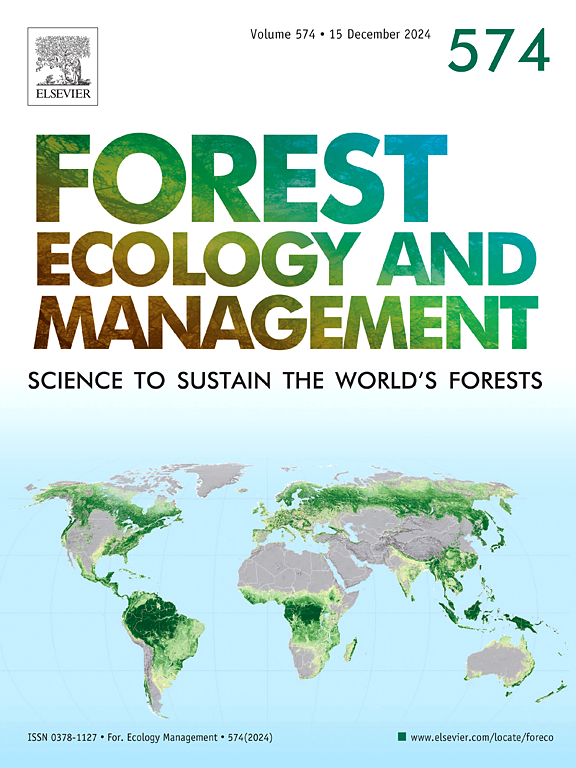黑松林生态系统组成对林分间伐的30年响应:原林属性、林分结构和林底小型哺乳动物
IF 3.7
2区 农林科学
Q1 FORESTRY
引用次数: 0
摘要
通过提高北方和温带森林的木纤维产量,可以通过疏林等造林处理来提高生物质产量。为了保护野生动物物种和生物多样性,恢复次生林中的旧森林结构属性也是非常必要的。我们问,在广泛的密度范围内进行商业前疏伐是否可以提高森林生产力,同时发展旧森林结构?我们测试了假设(H),即与未管理(未经思考和老生长)的林分相比,在30年内进行大规模商业前疏伐(重度疏伐至≤500棵/公顷)将增强作物树的(H1)结构特征(增加直径和高度生长以及树冠体积);(H2)基于农作物可销售体积和碳储存的生产力;(H3)老林结构属性的发展;以及(H4)森林地面小型哺乳动物的总丰度、物种丰富度和物种多样性。在加拿大不列颠哥伦比亚省中南部的三个研究区域,定位了四个重复的商业化前疏伐目标密度块,分别为250棵(极低)、500棵(低)、1000棵(中)和2000棵(高)树/公顷,未疏伐的白松和老生长林。树木和林分测量是在疏伐后30年进行的,当时林分年龄为43-47岁。2023年和2024年,小型哺乳动物被困在林分中。农作物树木的平均直径遵循密度模式,在极低密度林分中生长最快,在未经思考的林分中生长最低。平均树高在老林分中最高,在未经思考的林分中最低。在三个严重稀疏(≤1000棵/公顷)的林分中,明显可见非常大的树冠。这些结果部分支持H1。松树的平均适销量在老林分中最高,其次是未经思考和≥ 1000 树木/公顷变薄,因此不支持H2的这一部分。由于严重稀疏的林分中树冠非常大,林分之间的平均碳储量相似,并为H2提供了部分支持。由于入侵,四种疏林密度的作物树总密度相似,从1199棵树/公顷到1479棵树。严重疏伐的林分具有一些古老的森林属性,包括具有大量树冠的大型优势树木、针叶树的多层树冠、树冠间隙和林下斑块,因此支持H3。2023年,林分中小型哺乳动物的平均总丰度相似,但2024年,低密度、未经思考和老生长林分中的小型哺乳动物平均总丰度高于其他林分,因此部分支持H4。据我们所知,这是首次详细报告在现实世界规模和广泛密度下,对松疏林中树木生长指标和林分发育的30年响应。间伐后30年,大量间伐的林分恢复了间伐造成的潜在碳储量损失。商品木材可以通过大幅减少轮换来实现,这可能是解决当前和未来木材短缺的可行手段。在商业前疏伐30年后,恢复的森林可能有40-50年的历史,在某些方面至少与未砍伐的旧森林相当。本文章由计算机程序翻译,如有差异,请以英文原文为准。
Thirty-year responses of ecosystem components to stand thinning in lodgepole pine forest: Old-forest attributes, stand structure, and forest-floor small mammals
Biomass production via higher yields of wood fibre in boreal and temperate forests may be enhanced by silvicultural treatments such as stand thinning. Restoration of old-forest structural attributes in second-growth forests is also much needed for conservation of wildlife species and biodiversity. We ask if pre-commercial thinning over a wide range of densities could enhance forest productivity while concurrently developing old-forest structures? We tested the hypotheses (H) that, compared with unmanaged (unthinned and old-growth) stands, large-scale pre-commercial thinning (heavy thinning to ≤ 500 trees/ha) over a 30-year period, would enhance (H1) structural features (increase diameter and height growth and tree crown volume) of crop trees; (H2) productivity based on merchantable volume and carbon storage of crop trees; (H3) development of old-forest structural attributes; and (H4) total abundance, species richness, and species diversity of forest-floor small mammals. Four replicate blocks of pre-commercially thinned target densities of 250 (very low), 500 (low), 1000 (medium), and 2000 (high) trees/ha, unthinned, and old-growth stands of lodgepole pine (Pinus contorta var. latifolia) were located at three study areas in south-central British Columbia, Canada. Tree and stand measurements were conducted at 30 years post-thinning when stands were 43–47 years old. Small mammals were live-trapped in stands during 2023 and 2024. Mean diameter of crop trees followed the pattern of density with the highest growth in the very low-density stands and lowest in the unthinned stands. Mean tree heights were tallest in the old-growth stands and lowest in the unthinned stands. Very large tree crowns were evident in the three heavily thinned (≤ 1000 trees/ha) stands. These results partly supported H1. Mean merchantable volume of pine crop trees was highest in the old-growth stands and secondarily in the unthinned and ≥ 1000 trees/ha thinned stands, and hence did not support this part of H2. Mean carbon storage was similar among stands owing to the very large tree crowns in the heavily thinned stands and provided partial support for H2. Owing to ingress, total crop tree densities were similar among the four thinned stand densities ranging from 1199 to 1479 trees/ha. Heavily thinned stands had some old forest attributes including large dominant trees with substantial crowns, multi-layered canopies of coniferous trees, canopy gaps, and understory patchiness, and hence supported H3. Mean total abundance of small mammals was similar among stands in 2023 but higher in the very low-density, unthinned, and old-growth stands than other stands in 2024, and hence partly supported H4. To our knowledge, this is the first detailed reporting of the 30-year responses of tree growth metrics and stand development in thinned stands of lodgepole pine at a real-world scale and across a wide range of densities. Much of the potential carbon storage lost by thinning was restored in the heavily thinned stands at 30 years post-thinning. Merchantable timber may be achieved in a considerably reduced rotation and may be a viable means to address current and future timber shortfalls. Restored forests, at 30 years after pre-commercial thinning, may be 40–50 years old and be at least partly comparable to uncut old-forest in some respects.
求助全文
通过发布文献求助,成功后即可免费获取论文全文。
去求助
来源期刊

Forest Ecology and Management
农林科学-林学
CiteScore
7.50
自引率
10.80%
发文量
665
审稿时长
39 days
期刊介绍:
Forest Ecology and Management publishes scientific articles linking forest ecology with forest management, focusing on the application of biological, ecological and social knowledge to the management and conservation of plantations and natural forests. The scope of the journal includes all forest ecosystems of the world.
A peer-review process ensures the quality and international interest of the manuscripts accepted for publication. The journal encourages communication between scientists in disparate fields who share a common interest in ecology and forest management, bridging the gap between research workers and forest managers.
We encourage submission of papers that will have the strongest interest and value to the Journal''s international readership. Some key features of papers with strong interest include:
1. Clear connections between the ecology and management of forests;
2. Novel ideas or approaches to important challenges in forest ecology and management;
3. Studies that address a population of interest beyond the scale of single research sites, Three key points in the design of forest experiments, Forest Ecology and Management 255 (2008) 2022-2023);
4. Review Articles on timely, important topics. Authors are welcome to contact one of the editors to discuss the suitability of a potential review manuscript.
The Journal encourages proposals for special issues examining important areas of forest ecology and management. Potential guest editors should contact any of the Editors to begin discussions about topics, potential papers, and other details.
 求助内容:
求助内容: 应助结果提醒方式:
应助结果提醒方式:


